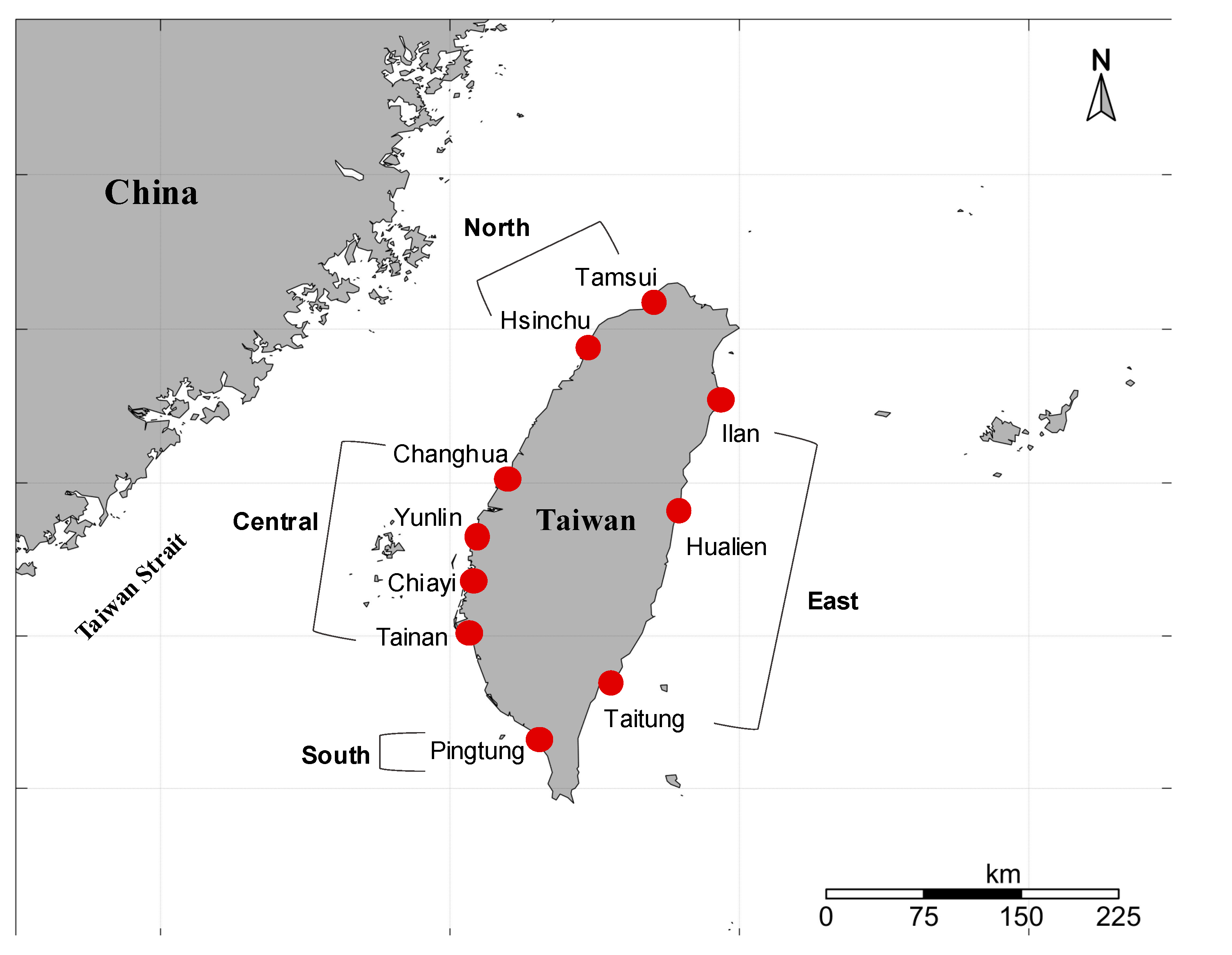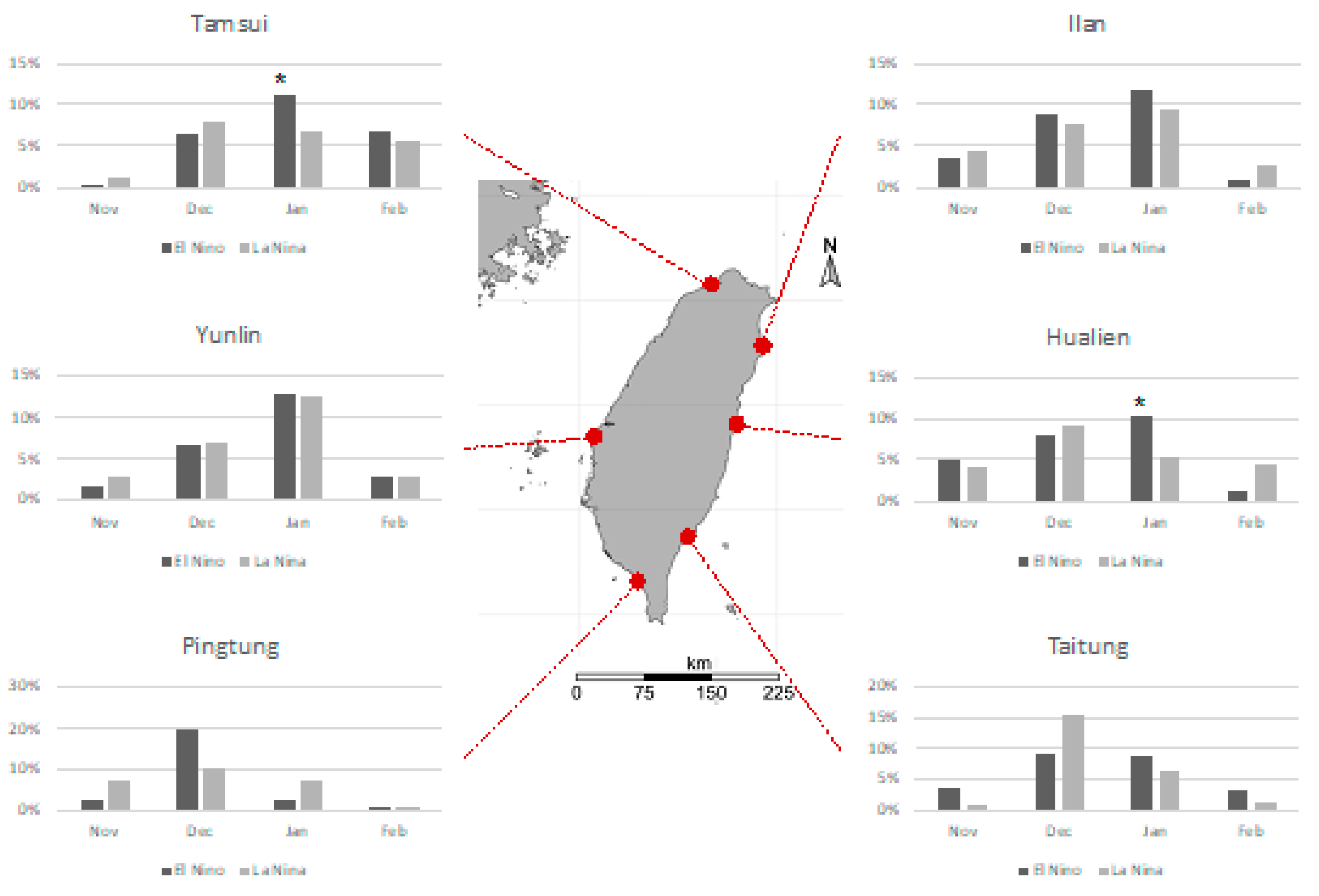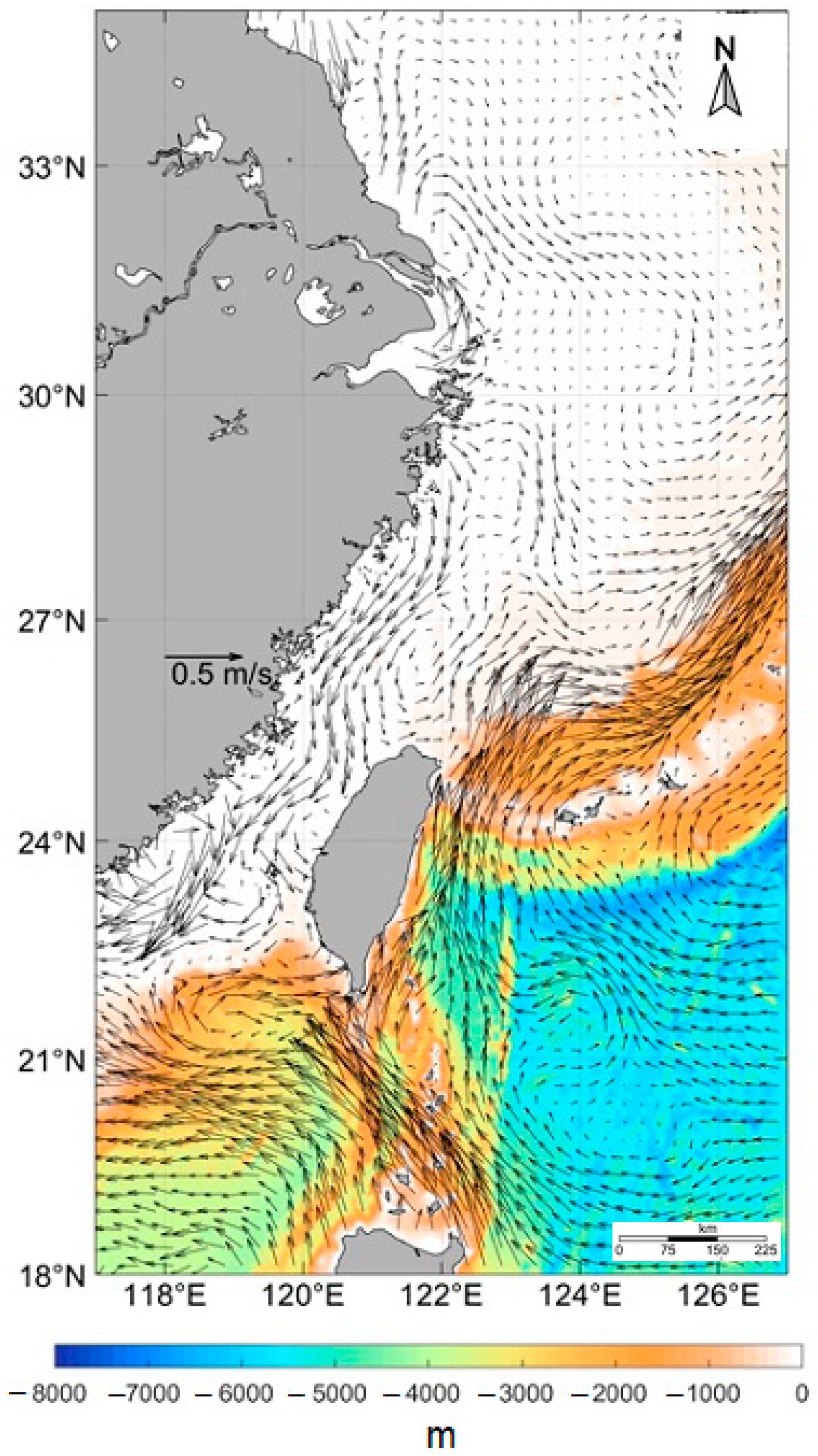Current Dependent Dispersal Characteristics of Japanese Glass Eel around Taiwan
Abstract
1. Introduction
2. Materials and Methods
2.1. Glass Eel Catch Information
2.2. Area Classification of Glass Eel Data
2.3. Temporal Extraction of the Glass Eel Data
2.4. Data Source to Distinguish the Phase of the ENSO Events
2.5. Current Velocity Data
2.6. Statistical Analysis
3. Results
3.1. Comparison of Glass Eel Recruitment Time Series from the Four Main Parts of Taiwan
3.2. Time Series of Glass Eel Recruitment in Each Fishing Area in Taiwan
3.3. Effects of ENSO Events on the Glass Eel Recruiting Month
3.4. Flow Field in Relation to Glass Eel Transport around Taiwan
4. Discussion
5. Conclusions
Supplementary Materials
Author Contributions
Funding
Institutional Review Board Statement
Informed Consent Statement
Data Availability Statement
Conflicts of Interest
References
- Tsukamoto, K.; Umezawa, A.; Ozawa, T. Age and Growth of Anguilla japonica Leptocephali Collected in Western North Pacific in July 1990. Nippon Suisan Gakkaishi 1992, 58, 457–459. [Google Scholar] [CrossRef][Green Version]
- Tsukamoto, K. Oceanic biology: Spawning of eels near a seamount. Nature 2006, 439, 929. [Google Scholar] [CrossRef]
- Tesch, F.W.; White, R.J. The Eel, 5th ed.; John Thorpe; John Wiley & Sons, Inc.: Hoboken, NJ, USA, 2008. [Google Scholar]
- Han, Y.S.; Zhang, H.; Tseng, Y.H.; Shen, M.L. Larval Japanese eel (Anguilla japonica) as sub surface current bio tracers on the East Asia continental shelf. Fish. Oceanogr. 2012, 21, 281–290. [Google Scholar] [CrossRef]
- Han, Y.-S.; Wu, C.-R.; Iizuka, Y. Batch-like arrival waves of glass eels of Anguilla japonica in offshore waters of Taiwan. Zool. Stud. 2016, 55, e36. [Google Scholar]
- Tsukamoto, K.; Otake, T.; Mochioka, N.; Lee, T.-W.; Fricke, H.; Inagaki, T.; Aoyama, J.; Ishikawa, S.; Kimura, S.; Miller, M.J. Seamounts, new moon and eel spawning: The search for the spawning site of the Japanese eel. Environ. Biol. Fishes 2003, 66, 221–229. [Google Scholar] [CrossRef]
- Tsukamoto, K.; Chow, S.; Otake, T.; Kurogi, H.; Mochioka, N.; Miller, M.J.; Aoyama, J.; Kimura, S.; Watanabe, S.; Yoshinaga, T.; et al. Oceanic spawning ecology of freshwater eels in the western North Pacific. Nat. Commun. 2011, 2, 179. [Google Scholar] [CrossRef]
- Han, Y.-S. Temperature-dependent recruitment delay of the Japanese glass eel Anguilla japonica in East Asia. Mar. Biol. 2011, 158, 2349–2358. [Google Scholar] [CrossRef]
- Cheng, P.W.; Tzeng, W.N. Timing of metamorphosis and estuarine arrival across the dispersal range of the Japanese eel Anguilla japonica. Mar. Ecol. Prog. Ser. 1996, 131, 87–96. [Google Scholar] [CrossRef]
- Nitani, H. Beginning of the Kuroshio. Kuroshio Phys. Asp. Japan Curr. 1972. [Google Scholar]
- Toole, J.M.; Millard, R.C.; Wang, Z.; Pu, S. Observations of the Pacific North Equatorial Current bifurcation at the Philippine coast. J. Phys. Oceanogr. 1990, 20, 307–318. [Google Scholar] [CrossRef]
- Tabeta, O.; Tanaka, K.; Yamada, J.; Tzeng, W.N. Aspects of the early life history of the Japanese eel Anguilla japonica determined from otolith microstructure. Nippon Suisan Gakkaishi 1987, 53, 1727–1734. [Google Scholar] [CrossRef][Green Version]
- Shinoda, A.; Aoyama, J.; Miller, M.J.; Otake, T.; Mochioka, N.; Watanabe, S.; Minegishi, Y.; Kuroki, M.; Yoshinaga, T.; Yokouchi, K.; et al. Evaluation of the larval distribution and migration of the Japanese eel in the western North Pacific. Rev. Fish Biol. Fish. 2011, 21, 591–611. [Google Scholar] [CrossRef]
- Otake, T.; Inagaki, T.; Hasumoto, H.; Mochioka, N.; Tsukamoto, K. Diel vertical distribution of Anguilla japonica leptocephali. Ichthyol. Res. 1998, 45, 208–211. [Google Scholar] [CrossRef]
- Kajihara, T. Distribution of Anguilla japonica leptocephali in western Pacific during September 1986. Nippon Suisan Gakkaishi 1988, 54, 929–933. [Google Scholar] [CrossRef]
- Wippelhauser, G.S.; McCleave, J.D. Precision of behavior of migrating juvenile American eels (Anguilla rostrata) utilizing selective tidal stream transport. ICES J. Mar. Sci. 1987, 44, 80–89. [Google Scholar] [CrossRef]
- Han, Y.S.; Hsiung, K.M.; Zhang, H.; Chow, L.Y.; Tzeng, W.N.; Shinoda, A.; Yoshinaga, T.; Hur, S.P.; Hwang, S.D.; Iizuka, Y.; et al. Dispersal characteristics and pathways of Japanese glass eel in the East Asian Continental Shelf. Sustainability 2019, 11, 2572. [Google Scholar] [CrossRef]
- Han, Y.-S.; Tzeng, W.-N.; Liao, I.-C. Time series analysis of Taiwanese catch data of Japanese glass eels Anguilla japonica: Possible effects of the reproductive cycle and El Niño events. Zool. Stud. 2009, 48, 632–639. [Google Scholar]
- Miller, M.J. Ecology of anguilliform leptocephali: Remarkable transparent fish larvae of the ocean surface layer. Aqua-BioScience Monogr. 2009, 2, 1–94. [Google Scholar] [CrossRef]
- Chen, J.-Z.; Huang, S.-L.; Han, Y.-S. Impact of long-term habitat loss on the Japanese eel Anguilla japonica. Estuar. Coast. Shelf Sci. 2014, 151, 361–369. [Google Scholar] [CrossRef]
- Tzeng, W.-N.; Tseng, Y.-H.; Han, Y.-S.; Hsu, C.-C.; Chang, C.-W.; Di Lorenzo, E.; Hsieh, C. Evaluation of multi-scale climate effects on annual recruitment levels of the Japanese eel, Anguilla japonica, to Taiwan. PLoS ONE 2012, 7, e30805. [Google Scholar] [CrossRef][Green Version]
- Jacoby, D.M.P.; Casselman, J.M.; Crook, V.; DeLucia, M.-B.; Ahn, H.; Kaifu, K.; Kurwie, T.; Sasal, P.; Silfvergrip, A.M.C.; Smith, K.G. Synergistic patterns of threat and the challenges facing global anguillid eel conservation. Glob. Ecol. Conserv. 2015, 4, 321–333. [Google Scholar] [CrossRef]
- Jacoby, D.; Gollock, M. Anguilla anguilla. The IUCN Red List of Threatened Species. Version 2014.2. 2014. Available online: https://www.iucnredlist.org/species/166184/176493270 (accessed on 5 January 2022).
- Itakura, H.; Kaino, T.; Miyake, Y.; Kitagawa, T.; Kimura, S. Feeding, condition, and abundance of Japanese eels from natural and revetment habitats in the Tone River, Japan. Environ. Biol. Fishes 2015, 98, 1871–1888. [Google Scholar] [CrossRef]
- Itakura, H.; Kitagawa, T.; Miller, M.J.; Kimura, S. Declines in catches of Japanese eels in rivers and lakes across Japan: Have river and lake modifications reduced fishery catches? Landsc. Ecol. Eng. 2015, 11, 147–160. [Google Scholar] [CrossRef]
- Dekker, W. Slipping through Our Hands: Population Dynamics of the European Eel; Universiteit van Amsterdam: Amsterdam, The Netherlands, 2004; ISBN 9074549101. [Google Scholar]
- Tanaka, H. Progression in artificial seedling production of Japanese eel Anguilla japonica. Fish. Sci. 2014, 81, 11–19. [Google Scholar] [CrossRef]
- Lin, Y.-J.; Tzeng, W.-N.; Han, Y.-S.; Roa-Ureta, R.H. A stock assessment model for transit stock fisheries with explicit immigration and emigration dynamics: Application to upstream waves of glass eels. Fish. Res. 2017, 195, 130–140. [Google Scholar] [CrossRef]
- Kimura, S.; Inoue, T.; Sugimoto, T. Fluctuation in the distribution of low salinity water in the North Equatorial Current and its effect on the larval transport of the Japanese eel. Fish. Oceanogr. 2001, 10, 51–60. [Google Scholar] [CrossRef]
- Kim, H.; Kimura, S.; Shinoda, A.; Kitagawa, T.; Sasai, Y.; Sasaki, H. Effect of El Niño on migration and larval transport of the Japanese eel (Anguilla japonica). ICES J. Mar. Sci. 2007, 64, 1387–1395. [Google Scholar] [CrossRef]
- Chang, Y.L.K.; Miyazawa, Y.; Miller, M.J.; Tsukamoto, K. Potential impact of ocean circulation on the declining Japanese eel catches. Sci. Rep. 2018, 8, 5496. [Google Scholar] [CrossRef]
- Hsiung, K.M.; Kimura, S.; Han, Y.S.; Takeshige, A.; Iizuka, Y. Effect of ENSO events on larval and juvenile duration and transport of Japanese eel (Anguilla japonica). PLoS ONE 2018, 13, e0195544. [Google Scholar] [CrossRef] [PubMed]
- Hsiung, K.M.; Kimura, S. Impacts of global warming on larval and juvenile transport of Japanese eels (Anguilla japonica). Deep. Res. Part II Top. Stud. Oceanogr. 2019, 169, 104685. [Google Scholar] [CrossRef]
- Zenimoto, K.; Kitagawa, T.; Miyazaki, S.; Sasai, Y.; Sasaki, H.; Kimura, S. The effects of seasonal and interannual variability of oceanic structure in the western Pacific North Equatorial Current on larval transport of the Japanese eel Anguilla japonica. J. Fish Biol. 2009, 74, 1878–1890. [Google Scholar] [CrossRef] [PubMed]
- Kuo, N.; Ho, C. ENSO effect on the sea surface wind and sea surface temperature in the Taiwan Strait. Geophys. Res. Lett. 2004, 31. [Google Scholar] [CrossRef]
- Hu, Z.; Qi, Y.; He, X.; Wang, Y.-H.; Wang, D.-P.; Cheng, X.; Liu, X.; Wang, T. Characterizing surface circulation in the Taiwan Strait during NE monsoon from Geostationary Ocean Color Imager. Remote Sens. Environ. 2019, 221, 687–694. [Google Scholar] [CrossRef]
- Chen, C.A.; Wang, S. Carbon, alkalinity and nutrient budgets on the East China Sea continental shelf. J. Geophys. Res. Ocean. 1999, 104, 20675–20686. [Google Scholar] [CrossRef]
- Nan, F.; Xue, H.; Yu, F. Kuroshio intrusion into the South China Sea: A review. Prog. Oceanogr. 2015, 137, 314–333. [Google Scholar] [CrossRef]
- Hickox, R.; Belkin, I.; Cornillon, P.; Shan, Z. Climatology and seasonal variability of ocean fronts in the East China, Yellow and Bohai Seas from satellite SST data. Geophys. Res. Lett. 2000, 27, 2945–2948. [Google Scholar] [CrossRef]
- Ichikawa, H.; Chaen, M. Seasonal variation of heat and freshwater transports by the Kuroshio in the East China Sea. J. Mar. Syst. 2000, 24, 119–129. [Google Scholar] [CrossRef]
- Tzeng, W.; Tsai, Y. Otolith microstructure and daily age of Anguilla japonica, Temminck & Schlegel elvers from the estuaries of Taiwan with reference to unit stock and larval migration. J. Fish Biol. 1992, 40, 845–857. [Google Scholar]
- Wang, B.; Wu, R.; Fu, X. Pacific–East Asian teleconnection: How does ENSO affect East Asian climate? J. Clim. 2000, 13, 1517–1536. [Google Scholar] [CrossRef]
- Zhang, R.; Sumi, A.; Kimoto, M. Impact of El Niño on the East Asian monsoon a diagnostic study of the’86/87 and’91/92 events. J. Meteorol. Soc. Japan. Ser. II 1996, 74, 49–62. [Google Scholar] [CrossRef]
- Li, C. Interaction between anomalous winter monsoon in East Asia and El Niño events. Adv. Atmos. Sci. 1990, 7, 36–46. [Google Scholar]
- Chen, W.; Graf, H.F.; Huang, R. The interannual variability of East Asian winter monsoon and its relation to the summer monsoon. Adv. Atmos. Sci. 2000, 17, 48–60. [Google Scholar]
- Meng, Q.; Wang, F.; Liu, N. Low-frequency variability of the North Equatorial Current bifurcation in the past 40 years from SODA. Acta Oceanol. Sin. 2011, 30, 14. [Google Scholar] [CrossRef]
- Chen, W.; Feng, J.; Wu, R. Roles of ENSO and PDO in the link of the East Asian winter monsoon to the following summer monsoon. J. Clim. 2013, 26, 622–635. [Google Scholar] [CrossRef]
- Huang, R.; Chen, J.; Wang, L.; Lin, Z. Characteristics, processes, and causes of the spatio-temporal variabilities of the East Asian monsoon system. Adv. Atmos. Sci. 2012, 29, 910–942. [Google Scholar] [CrossRef]
- Lee, J.-Y.; Lee, S.-S.; Wang, B.; Ha, K.-J.; Jhun, J.-G. Seasonal prediction and predictability of the Asian winter temperature variability. Clim. Dyn. 2013, 41, 573–587. [Google Scholar] [CrossRef]
- Wang, L.; Chen, W. An intensity index for the East Asian winter monsoon. J. Clim. 2014, 27, 2361–2374. [Google Scholar] [CrossRef]
- Zhang, R.; Li, T.; Wen, M.; Liu, L. Role of intraseasonal oscillation in asymmetric impacts of El Niño and La Niña on the rainfall over southern China in boreal winter. Clim. Dyn. 2015, 45, 559–567. [Google Scholar] [CrossRef]
- Hu, J.; Kawamura, H.; Li, C.; Hong, H.; Jiang, Y. Review on current and seawater volume transport through the Taiwan Strait. J. Oceanogr. 2010, 66, 591–610. [Google Scholar] [CrossRef]
- Chern, C.S.; Wang, J. The influence of Taiwan Strait waters on the circulation of the southern East China Sea. La mer 1992, 30, 223–228. [Google Scholar]





Publisher’s Note: MDPI stays neutral with regard to jurisdictional claims in published maps and institutional affiliations. |
© 2022 by the authors. Licensee MDPI, Basel, Switzerland. This article is an open access article distributed under the terms and conditions of the Creative Commons Attribution (CC BY) license (https://creativecommons.org/licenses/by/4.0/).
Share and Cite
Hsiung, K.-M.; Lin, Y.-T.; Han, Y.-S. Current Dependent Dispersal Characteristics of Japanese Glass Eel around Taiwan. J. Mar. Sci. Eng. 2022, 10, 98. https://doi.org/10.3390/jmse10010098
Hsiung K-M, Lin Y-T, Han Y-S. Current Dependent Dispersal Characteristics of Japanese Glass Eel around Taiwan. Journal of Marine Science and Engineering. 2022; 10(1):98. https://doi.org/10.3390/jmse10010098
Chicago/Turabian StyleHsiung, Kuan-Mei, Yen-Ting Lin, and Yu-San Han. 2022. "Current Dependent Dispersal Characteristics of Japanese Glass Eel around Taiwan" Journal of Marine Science and Engineering 10, no. 1: 98. https://doi.org/10.3390/jmse10010098
APA StyleHsiung, K.-M., Lin, Y.-T., & Han, Y.-S. (2022). Current Dependent Dispersal Characteristics of Japanese Glass Eel around Taiwan. Journal of Marine Science and Engineering, 10(1), 98. https://doi.org/10.3390/jmse10010098





